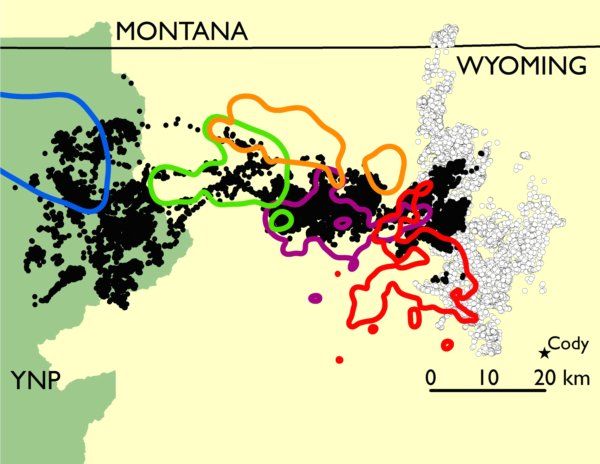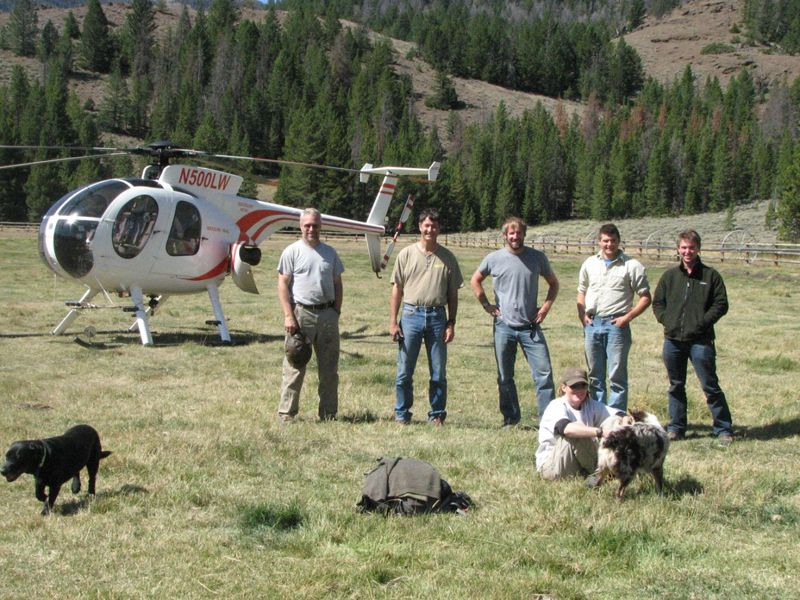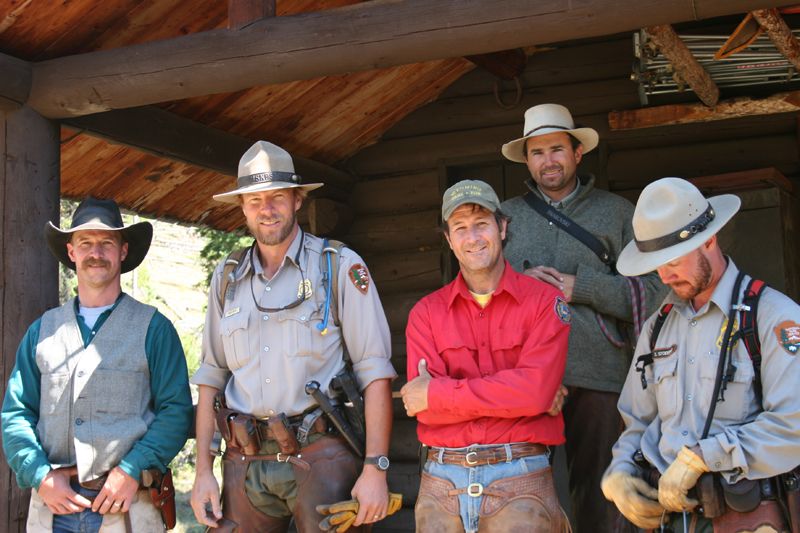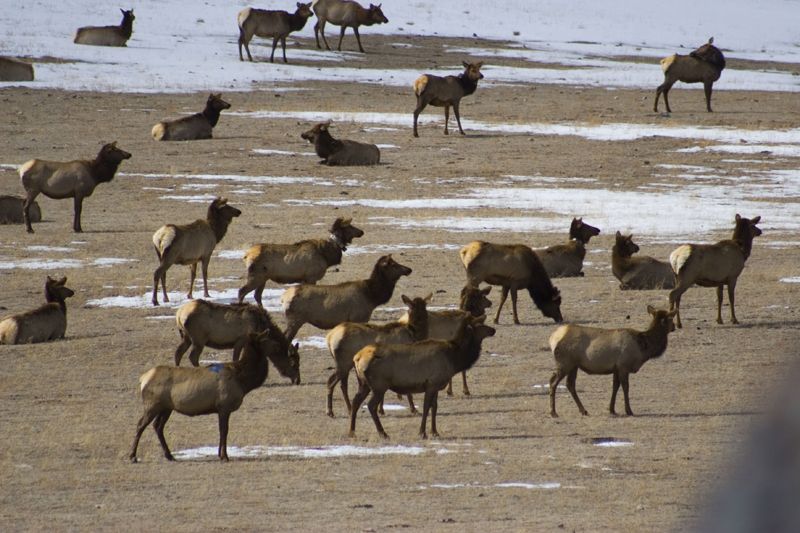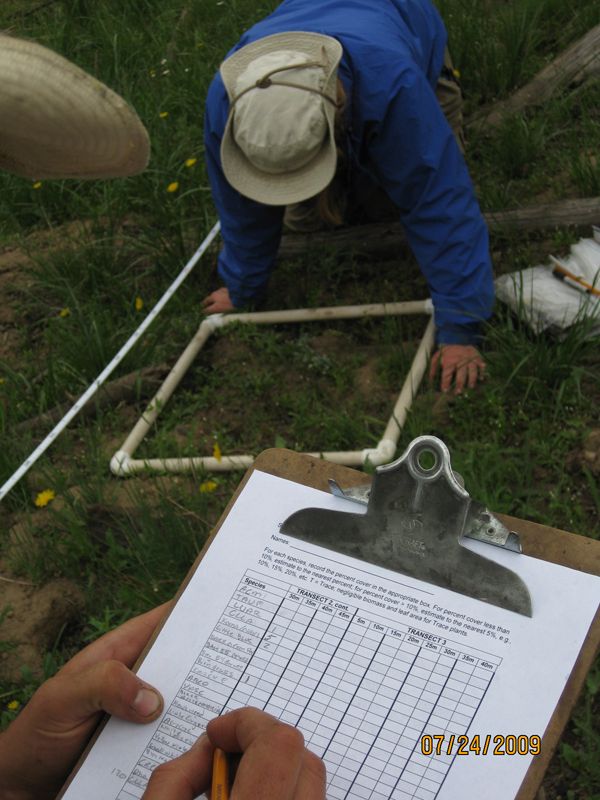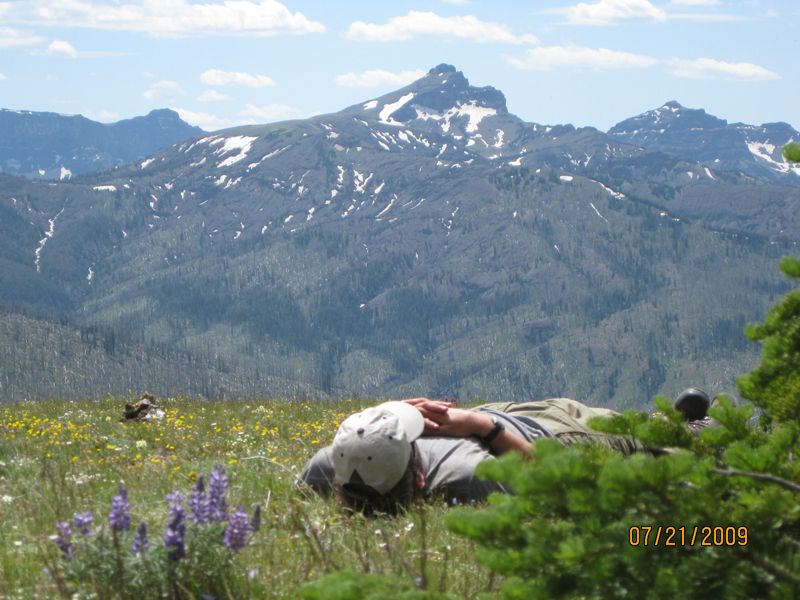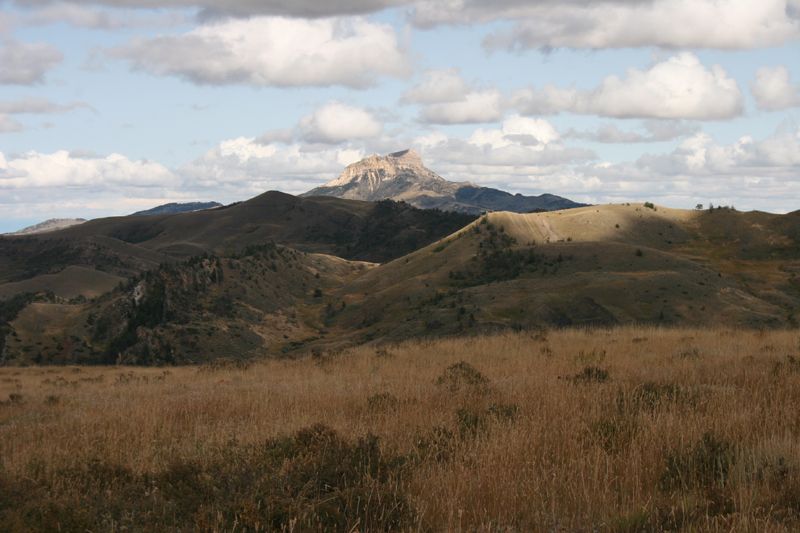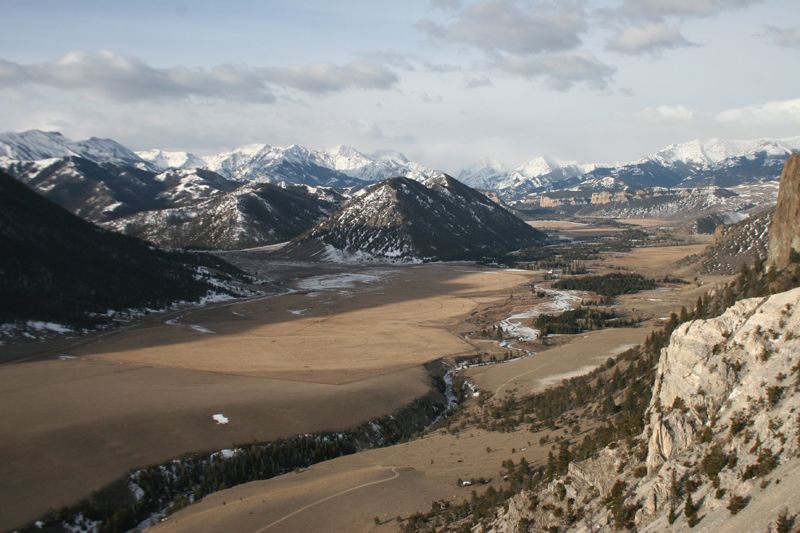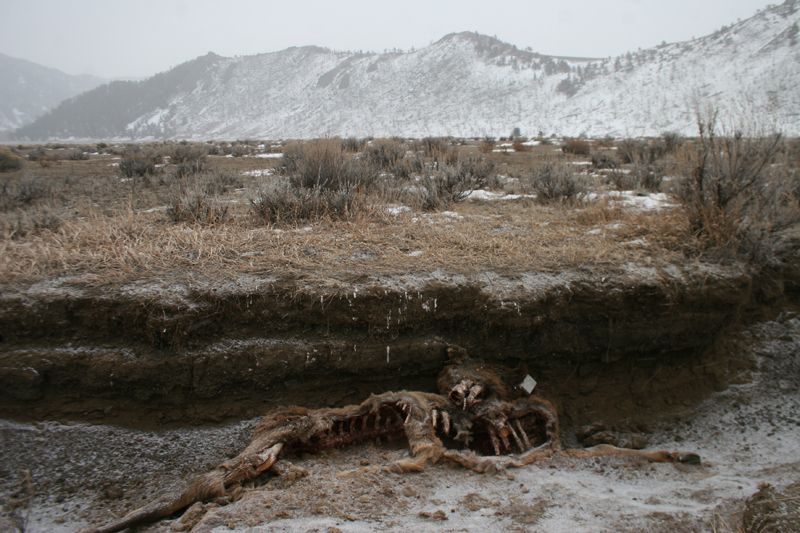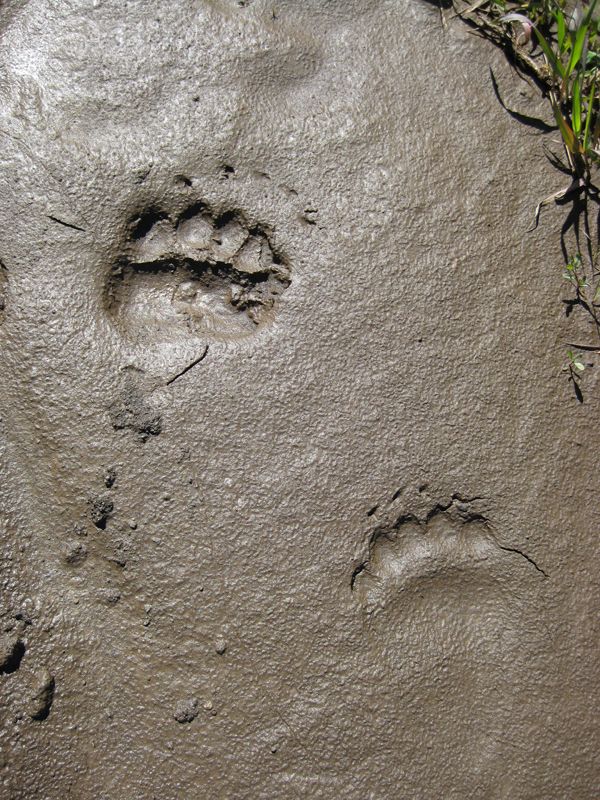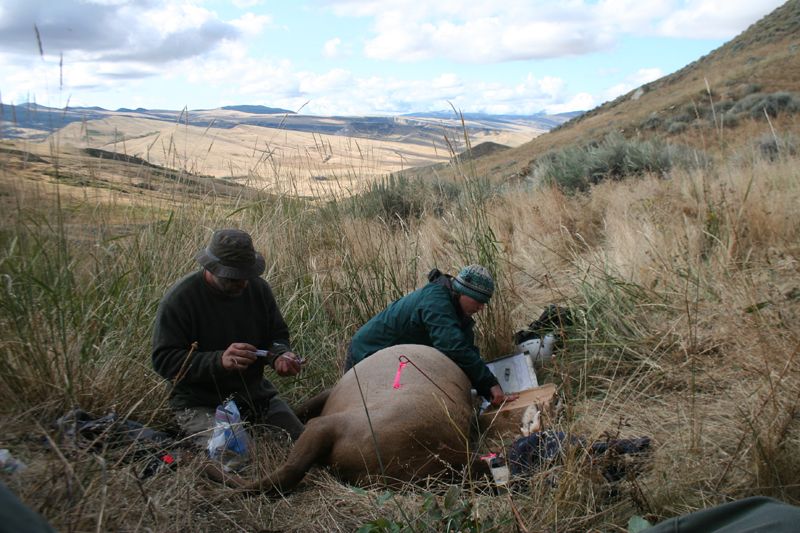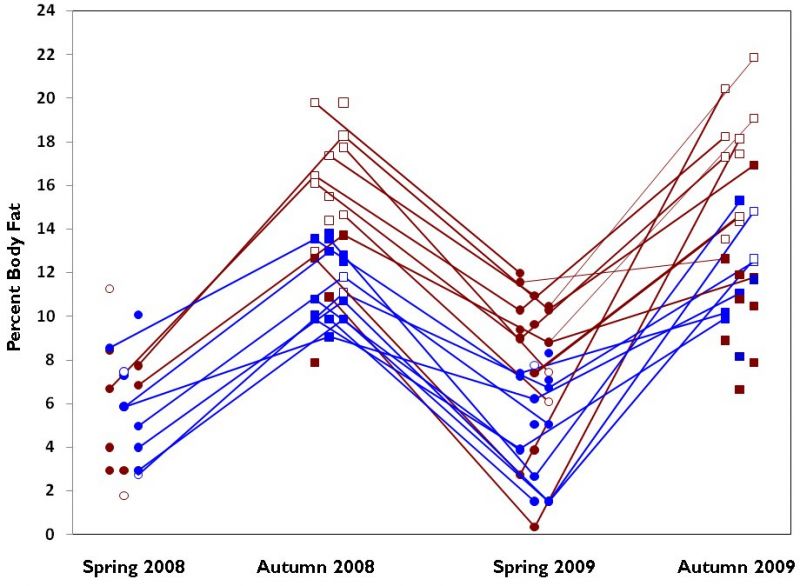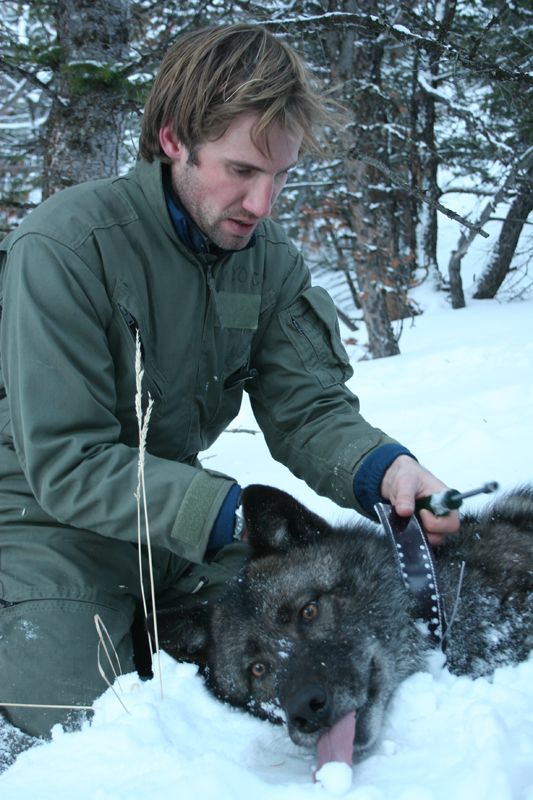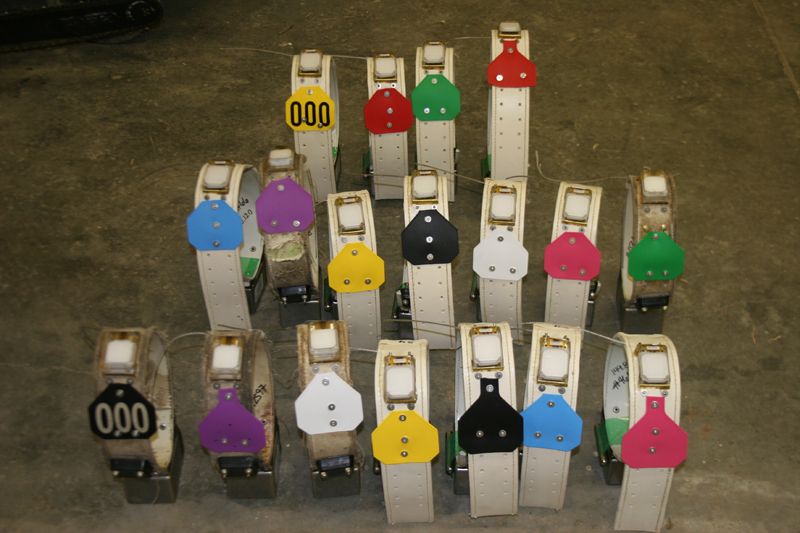We are working to understand the changing demography and distribution of the Clarks Fork elk herd, which ranges widely in the Absaroka Mountains between Cody, WY and the headwaters of the Lamar River inside Yellowstone National Park (YNP). Each summer, while resident Clarks Fork elk remain in the foothills of the Absaroka Front, their migratory counterparts travel 40-60 kilometers across the Absaroka Divide to summer in high-elevation alpine and subalpine habitats of YNP.
There, the migratory elk bear and nurse their calves, forage, and breed until the first substantial snows of winter, when they return to winter ranges neighboring and overlapping with those of resident elk. These two distinct strategies expose migrant and resident elk to very different predator densities and patterns of summer climate and plant growth – including access to irrigated fields for the resident elk.
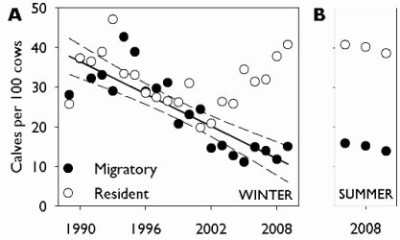 Long-term monitoring by the Wyoming Game and Fish Department (WGFD) and the results of our research suggest that these large-scale environmental differences are causing changes in the demography, movements, and distribution of the Clarks Fork herd. Over the past decade, WGFD has documented declining calf recruitment among migratory elk versus stable or increasing recruitment among resident elk. Concurrently, the distribution of the herd has shifted about 20 kilometers eastward into the Absaroka foothills, favoring the resident subpopulation. These trends have brought management concern because the growing numbers of resident elk cause agricultural damage, compete with livestock for native grasses, and may threaten cattle with brucellosis. Meanwhile, shifting patterns of elk productivity have brought changes to hunter opportunity, including curtailed hunting of migratory elk and limited hunter access to large numbers of resident elk that frequent private land refuges.
Long-term monitoring by the Wyoming Game and Fish Department (WGFD) and the results of our research suggest that these large-scale environmental differences are causing changes in the demography, movements, and distribution of the Clarks Fork herd. Over the past decade, WGFD has documented declining calf recruitment among migratory elk versus stable or increasing recruitment among resident elk. Concurrently, the distribution of the herd has shifted about 20 kilometers eastward into the Absaroka foothills, favoring the resident subpopulation. These trends have brought management concern because the growing numbers of resident elk cause agricultural damage, compete with livestock for native grasses, and may threaten cattle with brucellosis. Meanwhile, shifting patterns of elk productivity have brought changes to hunter opportunity, including curtailed hunting of migratory elk and limited hunter access to large numbers of resident elk that frequent private land refuges.
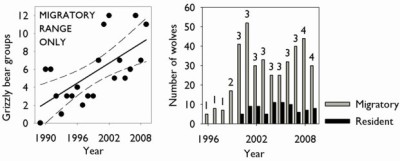 Studies conducted inside YNP, coupled with observations of higher bear and wolf numbers on the summer range of migratory Clarks Fork elk, indicate that the rate of calf predation is higher for migratory calves than for resident calves. In particular, YNP studies show that grizzly bears are the primary predator of elk calves. Meanwhile, the underlying pregnancy
Studies conducted inside YNP, coupled with observations of higher bear and wolf numbers on the summer range of migratory Clarks Fork elk, indicate that the rate of calf predation is higher for migratory calves than for resident calves. In particular, YNP studies show that grizzly bears are the primary predator of elk calves. Meanwhile, the underlying pregnancy rate of migratory elk – especially of young and lactating females – has recently been low. The low pregnancy rate of migrants appears to be caused by warmer and drier growing seasons and faster green-up disproportionately affecting their high-elevation summer range (which we can see via satellite imagery for the period 1989-2009). In contrast, we have detected no changes in green-up, or associated pregnancy reductions, in the habitats of resident elk. Therefore, it appears that fewer elk calves are born and more are killed by predators on the summer range of migratory elk, leading to their lower productivity over the past decade.
rate of migratory elk – especially of young and lactating females – has recently been low. The low pregnancy rate of migrants appears to be caused by warmer and drier growing seasons and faster green-up disproportionately affecting their high-elevation summer range (which we can see via satellite imagery for the period 1989-2009). In contrast, we have detected no changes in green-up, or associated pregnancy reductions, in the habitats of resident elk. Therefore, it appears that fewer elk calves are born and more are killed by predators on the summer range of migratory elk, leading to their lower productivity over the past decade.
 The factors that limit elk pregnancy are poorly understood in the region, so we have focused much of our attention on this issue. One potential alternative explanation for low pregnancy rates is the risk of wolf predation. A recent hypothesis for such “stress,” “fear,” or “harassment” effects is that wolves reduce elk forage intake in winter by causing elk to be vigilant or to shift into poor-quality refuge habitats, leading to reduced body-fat levels and, ultimately, to lost pregnancies. The previous research on this question used somewhat indirect, short-term measures of elk nutrition and reproduction (e.g. from fecal pellets and urine) and broad-scale indices of wolf predation risk (e.g. wolf-elk ratios). To gain more direct insights, we tracked the simultaneous movements of individual elk and wolves using GPS collars, while also monitoring elk body-fat levels and reproduction through biannual recaptures and closely observing winter elk behavior.
The factors that limit elk pregnancy are poorly understood in the region, so we have focused much of our attention on this issue. One potential alternative explanation for low pregnancy rates is the risk of wolf predation. A recent hypothesis for such “stress,” “fear,” or “harassment” effects is that wolves reduce elk forage intake in winter by causing elk to be vigilant or to shift into poor-quality refuge habitats, leading to reduced body-fat levels and, ultimately, to lost pregnancies. The previous research on this question used somewhat indirect, short-term measures of elk nutrition and reproduction (e.g. from fecal pellets and urine) and broad-scale indices of wolf predation risk (e.g. wolf-elk ratios). To gain more direct insights, we tracked the simultaneous movements of individual elk and wolves using GPS collars, while also monitoring elk body-fat levels and reproduction through biannual recaptures and closely observing winter elk behavior.
Our results indicate that elk in the migratory subpopulation respond to wolves, but only when wolves approach within about 1 km (about 0.6 miles). We see small increases in vigilance behavior, movement rates, and displacement in the 12-24 hours after these encounters, but no changes in elk habitat use (which is dependent mainly on the time of day). And even though migratory Clarks Fork elk experience high wolf-elk ratios compared with many other sites in the GYE, a typical migratory elk encounters a wolf within 1 km less than once a week. Together with modest behavioral responses, this relatively low encounter rate suggests we should not expect large, cumulative nutritional losses due to wolves.
Along these lines, our analysis indicates that elk body-fat losses over winter are not related to the frequency of 1-km wolf encounters. Instead, the starting body-fat levels of a cow elk in autumn – that is, the amount of fat she was able to gain on summer range – is a much stronger predictor of over-winter fat loss and March body-fat levels. We also found that the frequency of wolf encounters is not related to pregnancy status. These findings cast doubt on any link between the “fear” or “stress” of wolf predation and recent changes in the distribution, productivity, and abundance of elk. Among the elk we study (as discussed above), it seems more likely that the severe drought of the past decade, acting on an ageing elk population, has reduced elk pregnancy – and that predators, particularly bears, kill many of the newborn elk calves.
Ultimately, we aim for our findings to answer the questions of regional wildlife managers and stakeholders who are concerned about recent changes in the Clarks Fork herd and other similar, partially-migratory elk herds in the Greater Yellowstone Ecosystem. More broadly, we aim to improve ecologists’ understanding of whether and how predators influence the behavior, physical condition, and reproduction of their prey (i.e., “nonconsumptive” predator effects), and how these interactions might combine with other factors to influence elk migration in the Greater Yellowstone Ecosystem.
This project has been a collaboration of the Wyoming Cooperative Fish & Wildlife Research Unit, the Wyoming Game & Fish Department, and the U.S. Fish & Wildlife Service. We have received invaluable cooperation from additional agency partners including the National Park Service (Yellowstone Center for Resources) and the U.S. Forest Service, and many private ranches in the Cody area – as well as financial and logistical support from numerous non-governmental cooperators and sponsors.
Reports & Publications
Middleton, A.D., M.J. Kauffman, D.E. McWhirter, M.D. Jimenez, R.C. Cook, J.G. Cook, S.E. Albeke, H. Sawyer, and P.J. White. 2013. Linking antipredator behavior to prey demography reveals the limited risk effects of an activly hunting large carnivore. Ecology Letters, in press. ESA Portland 2012 Abstract.
Middleton, A.D., M.J. Kauffman, D.E. McWhirter, J.G. Cook, R.C. Cook, A.A. Nelson, M.D. Jimenez, and R.W. Klaver. 2013. Rejoinder: Challenge and opportunity in the study of ungulate migration amid environmental change. Ecology 94:1280-86.
Middleton, A.D., M.J. Kauffman, D.E. McWhirter, J.G. Cook, R.C. Cook, A.A. Nelson, M.D. Jimenez, and R.W. Klaver. 2013. Animal migration amid shifting patterns of phenology and predation: Lessons from a Yellowstone elk herd. Ecology 94:1245-56.
Nelson, A.A, M.J. Kauffman, A.D. Middleton, M.D. Jimenez, D.E. McWhirter, J. Barber, and K. Gerow. In press. Elk migration patterns and human activity influence wolf habitat selection in the Greater Yellowstone Ecosystem. Ecological Applications 22:2293-2307.
Project Reports:
Contact
Arthur Middleton, Donnelly Postdoctoral Fellow
Yale University
arthur.middleton@yale.edu | cell: (307) 460-0880
Doug McWhirter, Wildlife Biologist
Wyoming Game & Fish Department
2820 State Highway 120, Cody, WY 82414
doug.mcwhirter@wgfd.state.wy.usoffice: | (307) 527-7125
Mike Jimenez, Wyoming Wolf Project Leader
U.S. Fish & Wildlife Service
P.O. Box 2645, Jackson, WY 83001
mike_jimenez@fws.gov | office: (307) 733-7096 | cell: (307) 330-5631
Project Lead
Arthur Middleton completed his Ph.D. during summer 2012. He is now an associate research scientist at the Yale School of Forestry and Environmental Studies. During his time with the Wyoming Cooperative Fish and Wildlife Research Unit, Arthur coordinated the Absaroka Elk Ecology Project in collaboration with the Wyoming Game and Fish Department and the U.S. Fish and Wildlife Service, studying wolf-elk interactions in the Absaroka Range. MORE »

Timeline
Field work on the Absaroka Elk Ecology Project began in January 2007 with the capture and collaring of 60 adult female Clarks Fork elk and 6 wolves in the packs that hunt them. In winter 2008, additional GPS collars were added, and a series of recaptures was initiated in order to monitor elk body fat levels and reproduction. Additional wolves were captured and collared annually throughout the course of our field work. Field crews also completed three winter field seasons during 2008-2010 monitoring the time budgets and grouping behavior of collared elk. A companion project, conducted by Dan Tinker and Sara Beaver of the Department of Botany at the University of Wyoming, collected information on habitat quality of migrant and resident elk summer range during 2008 and 2009. The bulk of the field work on the Absaroka Elk Ecology Project was completed in spring and summer 2010, when elk GPS collars automatically dropped off. Several remaining wolf GPS collars dropped off in spring 2011. The project is now largely complete, though some additional analyses and reporting will continue into 2013.
Funding & Partners
Wyoming Game & Fish Department · Wyoming Animal Damage Management Board · U.S. Fish & Wildlife Service · Rocky Mountain Elk Foundation · Wyoming Governor’s Big Game License Coalition · Sportsmen for Fish & Wildlife · U.S. Forest Service – Shoshone National Forest · Boone & Crocket Club · University of Wyoming – National Park Service Research Station · Bowhunters of Wyoming · Pope & Young Club · Wildlife Heritage Foundation of Wyoming · Safari Club International · Cody Country Outfitters & Guides Association
Project acknowledgments
This project has benefited from the cooperation of E. & B. Landmark, Heart Mountain, Mooncrest, Sunlight, Switchback, Trail Creek, and Two Dot ranches, as well as many other landowners and sportsmen in the area. For their roles in data collection to date we thank P.J. White, Doug Smith, Christie Hendrix, and Mike Ross of the National Park Service; Gary Brown, Chris Queen, Craig Sax, Mark Bruscino, and other staff of the Wyoming Game & Fish Department’s Cody regional office; Chuck Schwartz and Mark Haroldson of the U.S. Geological Survey and the Interagency Grizzly Bear Study Team; Jim Pehringer and Monty Nicholson of U.S.D.A. Wildlife Services; and Susannah Woodruff of the U.S. Fish and Wildlife Service. We thank Rick Swisher and Mark Shelton of Quicksilver Air (Fairbanks, AK), Jim Pope of Leading Edge Aviation (Lewiston, ID), Dave Stinson of Sky Aviation (Worland, WY), and David Rivers, Mark Keech, Wes Livingston, Mark McNay, and Jack Whitman for their assistance with animal captures. We also thank the field technicians who have worked on this project, particularly those who worked as crew leaders: Andrea Barbknecht, Trent Roussin, and Travis Zaffarano. Many others, too numerous to thank here in name, have contributed time, expertise, and local knowledge in the field. Last but certainly not least, we appreciate the work of Mandi Larson in helping to manage this project.

